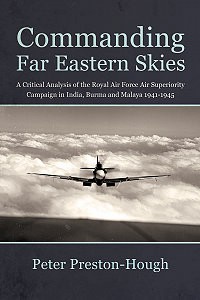‘Ten there was this book ‘COMMANDING FAR EASTERN SKIES’! The RAF-campaign for air supremacy above the border between India and Burma and unrolling eastward after that, is the topic of this study. Across the Indian border this succeeded, from September 1943 onwards, after the deploy of Spitfires The eastward –above Burma and later Malakka- unrolling only had chance after the US Army Air Force made long distance hunters as the Mustang and Lightning available. In April 1945 there was finally really an air supremacy on the Japanese Army Air Force.
This study makes especially clear that the Japanese Air Force in South-East Asia, as part of the Army, was directed by non-Air Force Officers, and therefore was factually restricted to ground support to the Army. The chance to exploit their initial air supremacy, by attacking strategic targets in India and so to make the civilians of India clear that the end of the British supremacy also for them was near, slipped hereby through their fingers
The British seized their chance to build up their air defence and after the availability of the Spitfires also made that effectively. The short flight range of the Spitfire made offensive operations above, by Japan occupied Burma, unrealistic. That the Americans brought in battle their Army Air Force, had a dual goal; a) securing of the supply from India for the Chinese troops of Generalissimo Chiang Kai-sjeck in their battle against the Japanese and; b) withdrawing as many as possible Japanese forces in the battle over the Philippines, Formosa and Okinawa. Great strategic deploy of Air Forces!
This book analysis this development thoroughly. Like from an onion, peel after peel, consecutively, air warnings, deploy of planes, support of the ground offensives c.q. defence against Japanese attacks and finally the deploy of long distance hunters and – bombers to gain air supremacy, are peeled off. Admittedly seen from different perspectives but dealing with the same battleground, it gives you as non-scientific interested reader a Deja-vu feeling.
Striking is also the rather one-sided British view on this matter; only sporadically the American vision is shown and ‘zero’ Japanese view. What I also miss in this book are pictures of the deployed planes. Only on the cover we see a Spitfire. But there are three instruction posters included, which the allied pilots had to imprint; under no circumstance engage in a dogfight with Japanese hunters, because that was surely the receipt for suicide! Coming in from high, with maximum speed and trying to surprise the opponent. With or without success, getting away and then try again. A very different battle manner than the British in the Battle of Britain had developed!
Finally this: the after Pearl Harbour compelling march of Japanese fleet, army and air forces firstly stunned the British in such a way that they seriously thought they had to do with German pilots and planes. This not seriously taking of the Japanese Air Forces went so far that the Royal Navy by the ready making of their battleships Prince of Wales and Repulse, thanked for the offer of the RAF for air cover. Within one and a half hour they were sunk by Japanese bombers. Only after the deploy of the in the Battle of Britain hardened pilots, the upcoming ‘paralysis’ of the RAF in South-East Asia was broken.












Leave a Reply